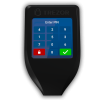Ledger vs Trezor – The hardware wallet comparison 2025
The hardware wallets from Ledger and Trezor are undoubtedly among the most popular. Ledger laid the foundation with the Ledger Nano S and Trezor with the Trezor One. In the meantime, both manufacturers have brought out successor models. These include the Ledger Nano X, Ledger Stax, Ledger Flex and the Ledger Nano S Plus and, on the other hand, the Trezor Model T, the Trezor Safe 3 and the Trezor Safe 5.

Ledger or Trezor? Which hardware should I buy?
The question therefore arises time and again: Which hardware wallet should I choose? I have tested all models extensively and try to help you with this guide to help you decide. If you have any questions about one of the hardware wallets, feel free to leave me a comment.
Quick overview between Trezor and Ledger
Comparison between Ledger and Trezor
The quick overview has already shown this: The two hardware wallet brands are quite similar. But there are also some differences, which are highlighted below.
General information about the two hardware wallets
The manufacturer Trezor launched the first hardware wallet on the market in 2014. It was invented by slush, who is still CEO and IT developer in his company SatoshiLabs. TREZOR is based in Prague in the Czech Republic. You can purchase the hardware wallet directly from there via the official store or via one of the resellers.
Ledger is a manufacturer from France that is probably one of the best-known hardware wallet manufacturers today. Ledger originated in Paris, France. You can purchase the hardware wallet directly from there via the official store or via one of the resellers.
In the following, I will discuss the biggest differences between the two hardware wallets from Ledger and Trezor. Details can be read in the respective test report:
Difference: Open Source
One difference that is already noticeable when comparing the criteria in the table above is that Ledger does not fully disclose its source code, as confidentiality agreements with secure chip manufacturers prevent the company from doing so. However, the specifications are completely open and detailed, and all cryptographic operations are deterministic. This enables every user to check whether the hardware wallets are doing what they are supposed to or whether there are side channels.
The hardware wallets from TREZOR, on the other hand, are completely open source. With the Trezor Safe 3, Trezor is now also installing a secure chip. But everything else is still open source.
Recovery seed password encryption difference
Most hardware wallets offer a password function. Such a password can be any word, string of letters, or even a phrase. You could also think of the passphrase as the 25th word of the recovery seed that is never stored on the device. So a passphrase generates a different wallet.
These settings are useful for having one main account and two or more hidden accounts from the same wallet, with the same 24 word recovery seed. Thus, even if you are in possession of the recovery seed, you cannot access the corresponding wallet without the password. Therefore, this feature is also suitable in case of blackmail by giving out a false password that unlocks a less important hidden account.
However, the TREZOR One and Ledger Nano S differed slightly in this advanced security feature.
With Trezor , this password is entered via the keyboard of the PC to which the wallet is connected. This makes it possible for attackers to read it out. With Ledger, on the other hand, the password is linked to another PIN, which you then type in using the normal keys.
Handling and operation
In principle, the first two models rely on the same input and output options: Two buttons and a small screen.
The design of the Ledger Nano S is a little better for attaching to a keychain, though, and it looks more like a USB flash drive – though you’ll need two hands to operate it here. The Trezor One and Trezor Safe 3 can be easily operated with one hand. But with this wallet, less device interaction is required anyway, as more input is taken from the controller.
However, things diverge a bit when it comes to the successor models. While the Ledger Nano X still relies on a small display with two buttons, the TREZOR Model T has a relatively large touchscreen with color display. But thanks to a rechargeable battery, the Ledger Nano X can also be used on the go via a Bluetooth connection with a smartphone.
Supported Cryptocurrencies
Another point that distinguishes the two hardware wallets is the supported cryptocurrencies. Ledger clearly has the edge here with its hardware wallets, as new cryptocurrencies are regularly implemented here. But also at TREZOR the community is constantly working on new supports.
According to official information, the hardware wallets from Ledger and TREZOR support several thousand cryptocurrencies.
Ledger vs. TREZOR: Conclusion
At first glance, the Ledger and TREZOR hardware wallets don’t seem very different. But a close comparison of the two brands has shown that there are very real differences.
I personally prefer Ledger’s hardware wallets, even though the difference is not really big and both offer great security.
Which hardware wallet did you choose? Feel free to leave your thoughts in the comments.












Comments
Hey folks, just a heads up that the hardware wallet link seems to be broken, but you can easily find info about them with a quick search online. https://shop.ledger.com/?r=1434 (Affiliate Link)